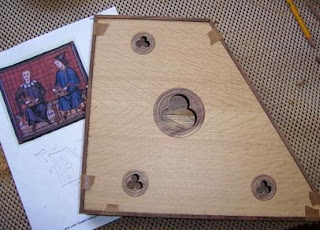 running around getting ready for Summer craft shows and art festivals.
running around getting ready for Summer craft shows and art festivals.The psaltery (right) will be done first, within a week or two, since it doesn't require as much carving. The picture in the photo is one of dozens from the Spanish 13th century Cantigas de Santa Maria illuminated manuscript, this one showing people playing small trapazoidal psalteries. This image was my inspiration for creating the white oak psaltery shown in the photo. The Cantigas de Santa Maria, sponsored/funded by Alfonso X, is one of the greatest illumunated manuscripts from the 1200s, and it is also one of the most complete surviving "paper" works from that era. Most of the illuminations are of figures playing various instruments of that time. It is of incredible historical importance on the evolution of musical instruments in Europe
The other white oak instrument I'm currently working on is a small Epinette des Vosges. It is based on one that sold several years ago that I found on a musical instrument  dealer's web site. It is reported to be from 1850, and the measurements given show it as being a very small instrument, barely 19 inches long. It is a board zither without a raised fingerboard. The frets are attached directly to the soundboard. This is an old style that dates back to the scheitholts of the 1600s. Frets on board zithers were either wire "staples" or wood (like on early Norwegian langeleiks). I, of course, used modern fret wire, but it is very small and similar in thickness to the wire staples used on the early board zithers.
dealer's web site. It is reported to be from 1850, and the measurements given show it as being a very small instrument, barely 19 inches long. It is a board zither without a raised fingerboard. The frets are attached directly to the soundboard. This is an old style that dates back to the scheitholts of the 1600s. Frets on board zithers were either wire "staples" or wood (like on early Norwegian langeleiks). I, of course, used modern fret wire, but it is very small and similar in thickness to the wire staples used on the early board zithers.
 dealer's web site. It is reported to be from 1850, and the measurements given show it as being a very small instrument, barely 19 inches long. It is a board zither without a raised fingerboard. The frets are attached directly to the soundboard. This is an old style that dates back to the scheitholts of the 1600s. Frets on board zithers were either wire "staples" or wood (like on early Norwegian langeleiks). I, of course, used modern fret wire, but it is very small and similar in thickness to the wire staples used on the early board zithers.
dealer's web site. It is reported to be from 1850, and the measurements given show it as being a very small instrument, barely 19 inches long. It is a board zither without a raised fingerboard. The frets are attached directly to the soundboard. This is an old style that dates back to the scheitholts of the 1600s. Frets on board zithers were either wire "staples" or wood (like on early Norwegian langeleiks). I, of course, used modern fret wire, but it is very small and similar in thickness to the wire staples used on the early board zithers.There are a few more instruments I'm just getting started on, and I'll report on them as they start taking shape. There are also several new "types" of instruments and folk art waiting in the wings. In other words, they're still in the planning stages. Tune in later. Film at 11.


No comments:
Post a Comment